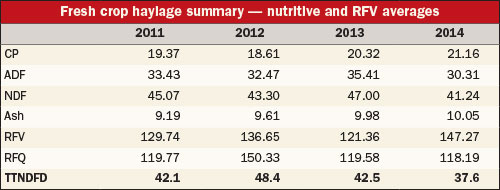
by Amanda Smith, Associate Editor
Across the Midwest, dairymen have noted that last year's crops are not feeding as well as anticipated. While this alone may cause a slight dip in the bulk tank's volume, those harvesting haylage in 2014 may have a few more challenges on the horizon. Wet weather early in the growing season hindered producers' ability to harvest at the ideal plant maturity. This has been coupled with dryer conditions throughout the summer months.
Since samples began arriving at Rock River Laboratory, they have seen an overall reduction in haylage quality when compared to 2012 and 2013, noted John Goeser, the lab's animal nutrition director. "On average, we're seeing less fiber, meaning higher Relative Feed Values (RFV) and more protein packed into silos, which would typically suggest better forage quality," he said.
Yet, for this year's haylage crop, RFV has been misleading. Relative Feed Quality (RFQ), a better measurement of quality, dropped in 2014. There has also been a marked reduction in total tract neutral detergent fiber digestibility, or TTNDFD (see chart). TTNDFD builds upon NDFD, RFQ and RFV by combining quality components and offering a value for the fiber availability during its time in a cow's rumen.

Predictions on initial haylage samples the lab analyzed came in around 40 percent TTNDFD. Goeser noted that typically a high-quality crop runs around 48 to 60 percent. If substantial amounts of poorer quality forage are fed in the diet, a several unit drop in TTNDFD can be attributed to a pound reduction in milk production.
Dan Undersander, with the University of Wisconsin, noted similar trends for alfalfa hay. He advises that producers have first-cutting alfalfa analyzed for fiber digestibility in addition to the usual fiber and crude protein analysis. This year, Undersander had seen RFQ values 40 to 50 points lower than RFV in first-cutting hay; the opposite is typically true.
Goeser's advice to producers: don't base your harvest timeline on the calendar. To harvest an optimal crop, monitor plant physiology and maturity early in the season or around 17 to 21 days postcutting, and measure feed quality when the crop goes into the silo. Then, strategies such as bringing in more digestible NDF or improving diet NDFD can be employed to avoid slumps in cow performance.








